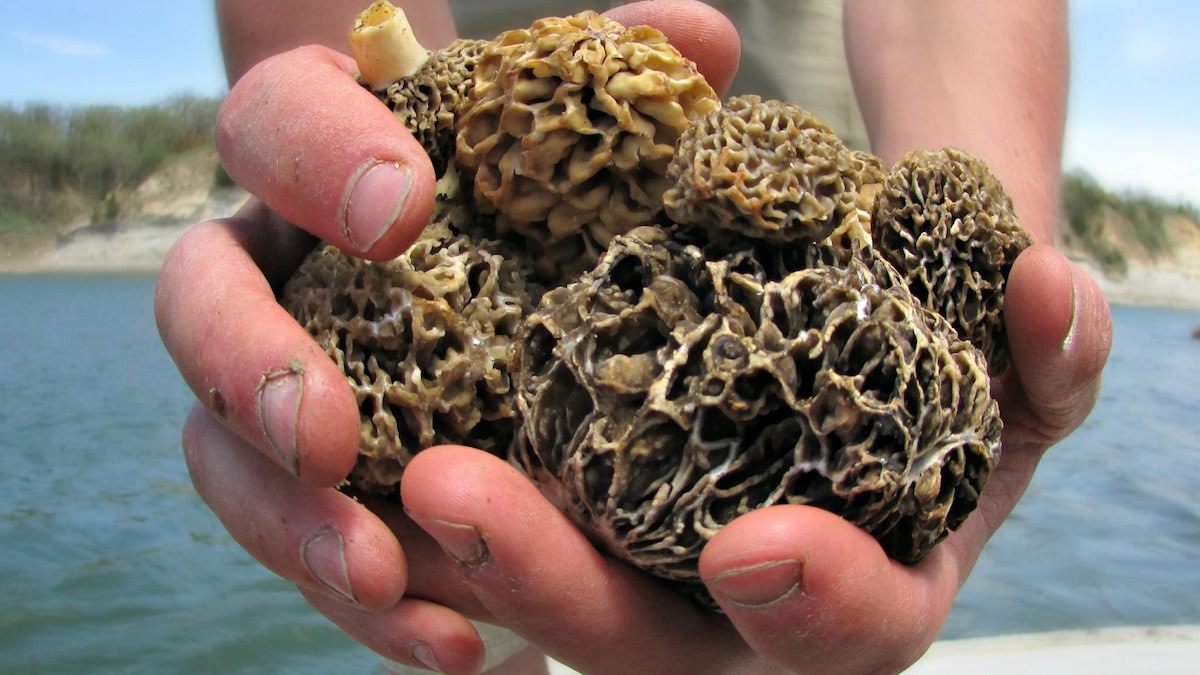
If there’s a higher pleasure than hunting while fishing (or fishing while hunting), I don’t know what it is. Whether it’s pass-shooting mallards during a fall trout float or breaking out the pack rod on a high mountain lake between bear glassing sessions, I feel somehow more engaged, excited, and satisfied than by those pursuits alone. I don’t know if Aristotle was a sportsman, but I’m sure this gets at what he meant when he wrote that the whole is greater than the sum of its parts.
You’ve probably heard the MeatEater crew extoll our love for cast & blast trips, but we’d like to add another phrase to our lexicon: Cast & Grasp. You see, it’s hard for me to be outside and not fishing this time of year, so I’ve learned to adapt in order to not miss out on the other seasonal bounties.
It just so happens that morel mushrooms often appear alongside the bass pre-spawn and many of the biggest insect hatches across the country, sometimes mere feet away from the fishing action. And don’t take my novice forager’s word for it; MeatEater’s mycology master Spencer Neuharth often talks about how riparian zones are among his favorite places to seek morels.
So, if you’re an angler looking to take home a little extra flavor this spring, or a diehard forager in need of some protein, here are a few tips for an epic mixed bag.
Walk Islands
Last spring I went to Idaho to report on a rainbow trout removal effort in the South Fork of the Snake River. I floated two days with Rob Parkins, BHA’s public waters access coordinator. True to title, Parkins parked the drift boat at several public parcels down the river corridor to look for golden goodness. It took me a hot minute to get my eyes attuned to the small, emergent morels in the thick grass, but before long we had a full grocery bag each.
Approaching these top-producing morel spots via water will consistently put you in places where other foragers are unlikely to venture. Next time you’re floating or wading a river, take a look at onX to visualize the boundaries of access sites and public lands intersecting the waterway. You can drop one angler off at the top of an island or public piece to walk the length while the others float around to the bottom. If you’re wading, also keep an eye on the map. Side channels can be very productive in the spring as river levels rise and fish move out of the heavy flow to feed and spawn. I like punching through cottonwood groves between the main flow and channels with my eyes glued to the ground for morels.
Park the Boat
If bass or other warmwater species are your devotion, all of this applies to your lake too. As you ride the trolling motor around the shoreline, keep an eye out for indicators of morel hotspots. What do those look like? Anything that has disturbed the soil. You’re already looking for trees fallen into the lake, right? Well, keep an eye out for trees fallen a little ways inland too. These are some of the best spots to locate those brain-like fungi.
Other red flags for soil disturbance are wildfire or prescribed burns, brush clearing projects, and previously flooded areas. If you can pull your eyes off the surface and sonar long enough to gaze up into the woods, consider parking the boat to take a stroll. There’s a good chance your significant other will be even more excited about a bag of the world’s most valuable mushrooms than another limit of crappies.
Bring Bags
Trust me, morels are less appetizing after they’ve ridden around in your chest pocket or hip pack for a few hours. For that and many other reasons, I now always include a 1- or 2-gallon Ziploc bag as a permanent fixture in all of my fishing and hunting packs. These are valuable not only for morels, but also a great way to transport a gutted trout off the river or a deer heart off the mountain. And if you’re among the more respectable sportsmen and women among us, you may also find occasion to pick up any trash you find and get it out of the wild places we all love.
Angler’s Eye
When I first started morel hunting deliberately—not just picking up the occasional cap I stumbled across while fishing—I was a little stunned by how hard they can be to see. I had some friends straight whoop my ass at filling bags. I knew I’d have to work hard to adjust my eyes to the new challenge.
It’s just like any outdoors pursuit: You need to acquire the mental picture before you can start really seeing the object of your attention. Be it the side profile of a deer, the silhouette of a hidden pike, the soft ripples of a trout eating an emerger, or a faraway band of ducks, we achieve more success when we know what we’re looking for and how to look for it. The same is true of small, golden morels in tall, golden grasses. Once you find one, get down low and examine it. Why is it here? How does it contrast with its surroundings? I also find that by getting down low near one, I’ll notice others around it that I might have walked right past. Slow down, take some time to appreciate the subtleties of these delicious fungi, and you’ll ultimately wind up with more in the sauté pan.
Feature image via Spencer Neuharth.







Conversation